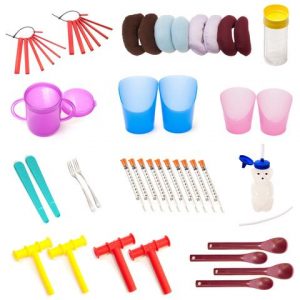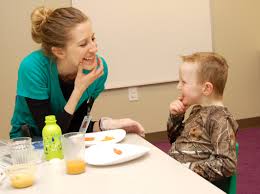
Feeding Therapy: Everything you need to know
Feeding Therapy: Everything you need to know
Feeding Therapy, Let us look at how we eat. we pick up the food from a plate. Take the food to the mouth, open the mouth and place the food in. with a variety of movements in the mouth we bite, chew, move the food from side to side and swallow it.
Soon after the birth, a baby starts sucking. As the child is growing, he learns to bite, chew, swallow and drink. Initially, the child is a messy eater, as he/she grows up, becomes good and quick in eating. But some children face difficulty in learning to eat. Some are choosy eaters, some take a long time to finish the meals. These children probably have feeding disorders.
Who might have feeding disorders?
- Premature babies
- Any damage to the brain during delivery, for example, cerebral palsy
- Cleft lip or palate
- Autism
- Down’s syndrome
- Head injury/Stroke
- Dysarthria-Weakness in muscles of face and neck
- Children with Poor strength, fewer movements in oro motor structures, for example, lips, tongue, and jaw.
- Sensory problems, like some children, do not like soft food, some children like only crisps.
- Behavioral problems. Examples, who are stubborn, who have negative opinions about certain foods.
What features are observed in children with feeding disorders?
- Continuous difficulty in breastfeeding as an infant
- Cries and makes a lot of fuss during a feed
- Poor learning in eating and drinking
- Difficulty to eat and drink
- Takes a long time to finish a meal
- Continuous drooling
- Vomiting after most meals
- Has problem in strength to bite and chew
- Sensory issues in the mouth
- Any structural and functional difficulties in the mouth
- One who is not gaining good weight
What happens if there is a continuous feeding disorder?
- Children will get poor nutrition, so they feel weak especially during any physical tasks.
- Food or liquid get into the air pipe, causing aspiration
- Negative feeling towards the food.
- Can face poor social interactions while eating with family and other gatherings.
- Consult a pediatrician, who will check for any medical conditions. He will monitor body growth and weight for a particular age.
- Consult a speech-language pathologist. Speech therapists will observe how the child moves their mouth while eating, drinking. She will also check if there is sufficient strength, movement with good accuracy. A detailed observation will be done on lips, tongue, jaw, and throat. She also observes child’s behaviors and reactions while eating.
After a detailed examination, a feeding therapy program will be planned. This is planned based on the child’s strengths and weaknesses in feeding.
What is feeding therapy?
A speech therapist will support the child to eat, drink and swallow better. She will use various techniques and tools to help the child who has feeding difficulties.
Following will be included in feeding therapy:
- Giving the child a lot of opportunities to touch, play and explore a variety of food, especially before mealtime. This will help children who are hypersensitive to food.
- Trying different textures, tastes, smells, and colors in the food.
- Changing a child’s position while eating. This will help the child to swallow easily.
- Focus on improving positive behavior towards eating.
- Focus on improving social interactions with family and others.
Oral placement therapy (OPT) in Feeding therapy:
OPT uses therapy tools to make the child/adult understand about mouth (lips, tongue, and jaw), different parts in the mouth, and make children how to move these parts required for speech and feeding. These also help in improving strength and good movement of the mouthparts.
Following are some of the feeding techniques used in OPT:
- Spoon feeding: Spoon feeding exercises will focus on lip closure, movement of tongue and jaw during spoon-feeding. Appropriate spoon position is important during a spoon feed. Spoon placement from sides of the lip, front of the lip and food sucking from the spoon will be taught.
- Cup drinking: Drinking from a cup can be very tricky if the mouth muscle’s strength and coordination of muscles are poor. Choosing the right cup is very important. Thickened liquid-like milkshake, applesauce will be introduced first. As the child learns, the liquid consistency is decreased, like buttermilk, coconut water. During cup drinking, lip closure, movements of tongue and jaw will be worked on.
- Straw drinking: Begin with large diameter straws and slightly thickened liquids. This will be an easier step to begin straw drinking. As the child gets good control over this wide-diameter straw, reduce the straw diameter and increase the thickness of the liquid. Children can feed themselves independently here.
- Eating solid food: Children with feeding difficulties usually prefer puree food or soft food. These soft foods are easy to eat. Example carrot sticks, crisps, chapati, dosa, idli.
The general outcome of feeding therapy:
- Exercises will improve strength in mouth muscles.
- Tongue movements will improve, so that food child can move the food easily from one side to other
- Will add new taste and texture to child food
- The child will be an independent eater
- The child will be comfortable with new food taste and texture
- The behavior in mealtime will improve
These are general ideas of feeding therapy. Detailed testing and observation will be made in the beginning. Later on, a detailed feeding therapy program will be planned according to the child’s likes and dislikes. The child’s strengths and weaknesses will be taken into consideration. For further assistance, please contact your speech therapist at 1Specialplace.
If you wish to know more about Speech Therapy, kindly contact us at info@1specialplace.com
For more ideas check out our other blogs
- Feeding Therapy: Everything you need to know - February 28, 2021
- Fun Movement Activities for Speech Development - February 15, 2021
- Speech therapy for Apraxia-Tips and strategies - July 14, 2020




Leave a Comment
(0 Comments)